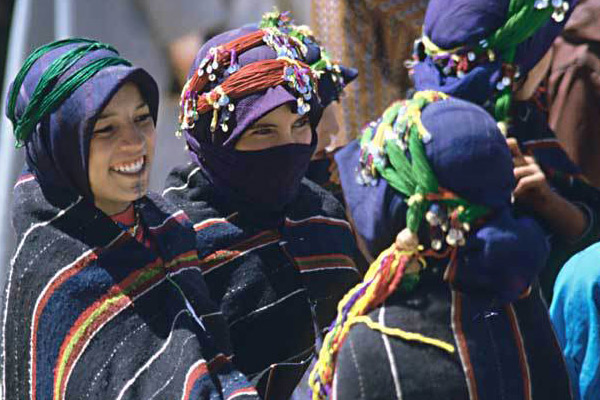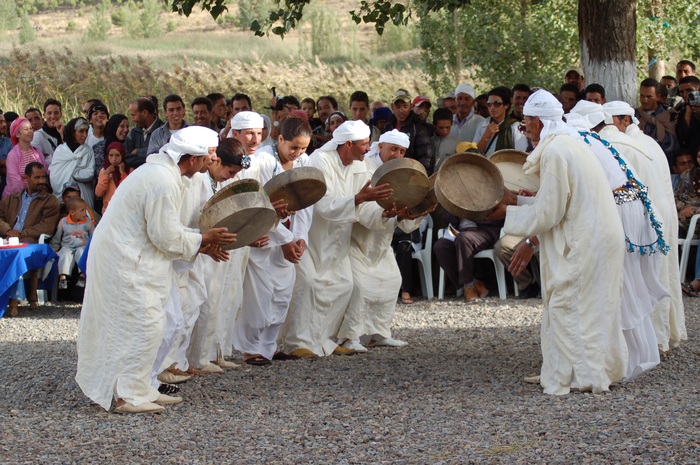
The Imilchil festival for marriage hosted by Rashidiya province usually in September, a destination for visitors and tourists from all over the world (including Moroccans), as well as researchers in folklore and anthropology, because of the implications of this popular Amazighi demonstration, which is one of a kind.
The festival is painted with colors of mythology fused with popular surrealism of the Ait Hdido’s tribesmen located in the Atlas Mountains at an altitude of 2000 meters.
In this period of the year, which is concurrent with the harvest season, the tribesmen gather to commemorate the legend of the lakes Isli and Tislit.
The legend tells the story of a young man named Moha and a sweet girl named Hadda.
They loved each other immeasurably, but – to their worst of luck – the adorable couple belonged to two feuding tribes which resulted in the rejection of their love and eventually their marriage. Incapable of living together, Moha and Hadda literally cried each other a river.
Their tears have created the lakes Isli (the groom) and Tislit (the bride). The legend of the lovers has become one of the pillars that shape the culture of the two tribes symbolizing free will.
However, this freedom is not absolute, but that it must receive the blessings of the couple’s kin.
The fundamental rule upon which the marriage of Ait Hdido’s newlyweds in Imilchil is to kidnap your bride and then marry her, otherwise you don’t deserve her! Kidnappings during the festival are of celebrative (dramatic) festivity in which the grooms play the role of the abductor simulating the abductions prevailed in the ancient times.

When you watch the ritual of courtship season, you will find yourself lost in a world where the real and surreal are one and the same.
The couples who wish to marry each other must get to know each other – before the season of course; and they are to tie the knot in the same season, in which notaries prepare the marriage contracts orally and in writing by normal societal rules in the country
The tribes must take great care of the bride of Imilchil season and so you see her putting on kohl on her haunting eyes, and speckles her cheeks with red dots, claiming that the red color would ward off the evil eye; and then she meticulously positions it around her eyebrows to highlight her beauty and tenderness.
And then, she would finish it all off with the big, circled earrings and a magical Bohemian necklace with its red and yellow stones akin to the Moroccan rosaries.
Everyone who is invited to the wedding must come in traditional, new clothes. Young men often wear an Amazigh turban which is often made of fine cloth, and are dressed in Amazighi robes/Djellaba and Burnoose in their gorgeous light, green and brown colors.
The first scene of this fictional movie involves the one single rule: Kidnap the bride, you get her! Therefore, if the groom was unable to complete the mission, he is not worthy of marrying her!
It should be noted that a married woman’s headdress is conical towards the top, whereas a virgin’s headdress is horizontal. When the bride leaves her parents’ home, her strongest cousins surround her while armed with palm fronds.
The palm fronds will be used to hit the poor groom for quite some time until he is able to hold the reins of the mule to be ridden by the bride!
The significance of this excruciating process is to demonstrate the groom’s courage and the patience to endure hardship. Following the marriage completion: the couple and their kin share a huge loaf of bread larger than one square meter, as a sign of the sacred bond between the two united families.
The scenes of the Imilchil season scenario keep flowing like a romantic movie, as the bride (wearing her dress) must take a shower in the waters of the lakes (Isli and Tislit) in broad daylight before everyone.In addition to these scenes, there comes the groom in his white robe and his corpulent horse to add a legendary flavor full of magic, joy and romance that tickles the feelings of the grooms and brides to be.
First, a group of 10 members (5 men and 5 women) is formed, then the group head for the bride’s new home to give her gifts: clothing, jewelry, and beefy full-fat sheep, a loaf of bread the diameter of which is 1 meter, with 25 kg of flour and knead with ten liters of water, after adding the right amount of salt.
It’s usually the men who bake it and not the women. When baked, the bread is distributed among the members of the 2 families – as a symbol of love and acquaintance.
The bride’s family hosts the guest by giving them dates, butter, honey, and milk. Then, the bride would put on her white wedding dress and her jewelry, and just before she leaves her parents’ home, the father would put his Burnoose below her feet as a sign of his blessing to the marriage.